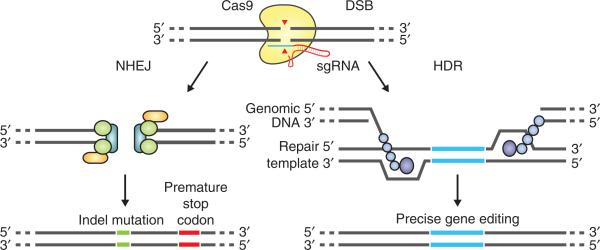Gene Knock-In Cell Line Construction Service
Creative Bioarray has many years of experience in stable cell line construction services. Our gene-editing platform can successfully achieve fragment insertion, single gene knock-in, point mutation, and insertion of reporter genes. Use the most cutting-edge technology and equipment to provide you with diverse solutions for gene knocking into stable cell lines. We have established a mature agreement and can provide you with cell lines that can stably express knock-in genes according to your needs.
Gene Knockin
All nucleases used for genome editing in mammalian cells can trigger double-stranded DNA (dsDNA) breaks at specific genomic sites. Then gene editing is completed through two main DNA repair pathways, non-homologous end joining (NHEJ) or homology-directed repair (HDR). For example, zinc finger nuclease, transcription activator-like effector nuclease (TALEN), CRISPR/Cas9. In order to generate knock-in cell lines, HDR is essential for inserting the tag of interest, which is done in the presence of a repair template introduced by exogenous sources during the dsDNA break. The CRISPR/Cas9 system usually single guide RNA (sgRNA) guides the Cas9 nuclease to the target sequence and induces a DNA double-strand break (DSB). Then, the DSB has been repaired through the non-homologous end joining (NHEJ) pathway, resulting in micro-insertions or micro-deletions (indel) or precise gene or nucleotide substitutions through HDR. In the presence of the donor DNA template, the homologous recombination (HR) approach is used to a lesser extent to accurately replace the damaged DNA sequence. Gene knock-in of cell lines is carried out through these features of nuclease and DNA repair.
 Fig 1. DSB repair promotes gene editing. (Danner E, et al. 2017)
Fig 1. DSB repair promotes gene editing. (Danner E, et al. 2017)
Knockin Cell Lines Constructed with CRISPR
Knockin stable cell lines are defined as cell lines formed by inserting GOI into sites of natural interest. We are experts in gene knock-in using CRISPR/Cas9, from designing gRNA constructs to forming stable cell lines. Our gene knock-in cell line construction service can generate stable cell lines with permanent knock-in target genes. Our service can permanently knock into your GOI at the desired genomic target site to generate a customized stable cell line. Using the target gene provided by the customer, we provide cost-effective gene knock-in services. The CRISPR-based method introduces GOI into a specific site in the genome to achieve stable GOI knock-in. The target site-specific gRNA is transfected with Cas9 and a donor vector as a template for HDR-mediated gene knock-in. Through homology-directed repair methods, a single donor sequence with homology arms can be introduced into the locus. The final customized cell line will be evaluated by sequencing the target locus to confirm whether it has been successfully knocked in. At the same time, we will also conduct a series of standard QC tests on the final stable cell line to evaluate the quality of the final cell line product, such as the sterility test and mycoplasma test.
 Fig 2. Gene knockin stable cell construction service process
Fig 2. Gene knockin stable cell construction service process
Optional Services
➢ Conventional single gene knock-in
The site-specific, integrase-based gene-editing technology can be used to generate stable knock-in cell lines with large transgenes very efficiently and quickly. Knock-in is mediated by integrase at the pre-designed "dock site" in the intergenic transcriptionally active genomic site (safe harbor site), which is used for high-level gene expression without damaging internal genes;
➢ Reporter gene knock-in
On the basis of conventional GOI knock-in, the reporter gene is inserted into a specific site, driven by an endogenous promoter, reflecting the expression of the target gene. Provide customers with diversified choices according to their project needs;
➢ Point mutation and conditional point mutation
This service can generate stable cell lines containing the desired point mutations at the target site of the genome of interest. Use a CRISPR-based method to introduce target site-specific gRNA with Cas9 and single-stranded donor oligonucleotide (ssODN) into the cell as a template point mutation for HDR-mediated insertion.
➢ Conditional knock-in cell line
The inducible knock-in cassette is used to generate conditional knock-in cell lines. The most commonly used system is Cre/loxp. With the expression of Cre, the inserted gene is activated.
Creative Bioarray provides a variety of technical services from the editing of inserts to the construction of vectors to the formation of cell lines that stably express "foreign" genes. You will benefit from our technical expertise and uniform experimental platform, and provide you with the most suitable solution.
If you are interested in our services or have any specific needs, please feel free to contact us. We look forward to working with you in the near future.
References
- Danner E, Bashir S, Yumlu S, et al. Control of gene editing by manipulation of DNA repair mechanisms[J]. Mammalian Genome, 2017, 28(7): 262-274.
- Liu M, Rehman S, Tang X, et al. Methodologies for improving HDR efficiency[J]. Frontiers in genetics, 2019, 9: 691.
- Zhang J H, Adikaram P, Pandey M, et al. Optimization of genome editing through CRISPR-Cas9 engineering[J]. Bioengineered, 2016, 7(3): 166-174.
For research use only. Not for any other purpose.

 Fig 1. DSB repair promotes gene editing. (Danner E, et al. 2017)
Fig 1. DSB repair promotes gene editing. (Danner E, et al. 2017)
 Fig 2. Gene knockin stable cell construction service process
Fig 2. Gene knockin stable cell construction service process
